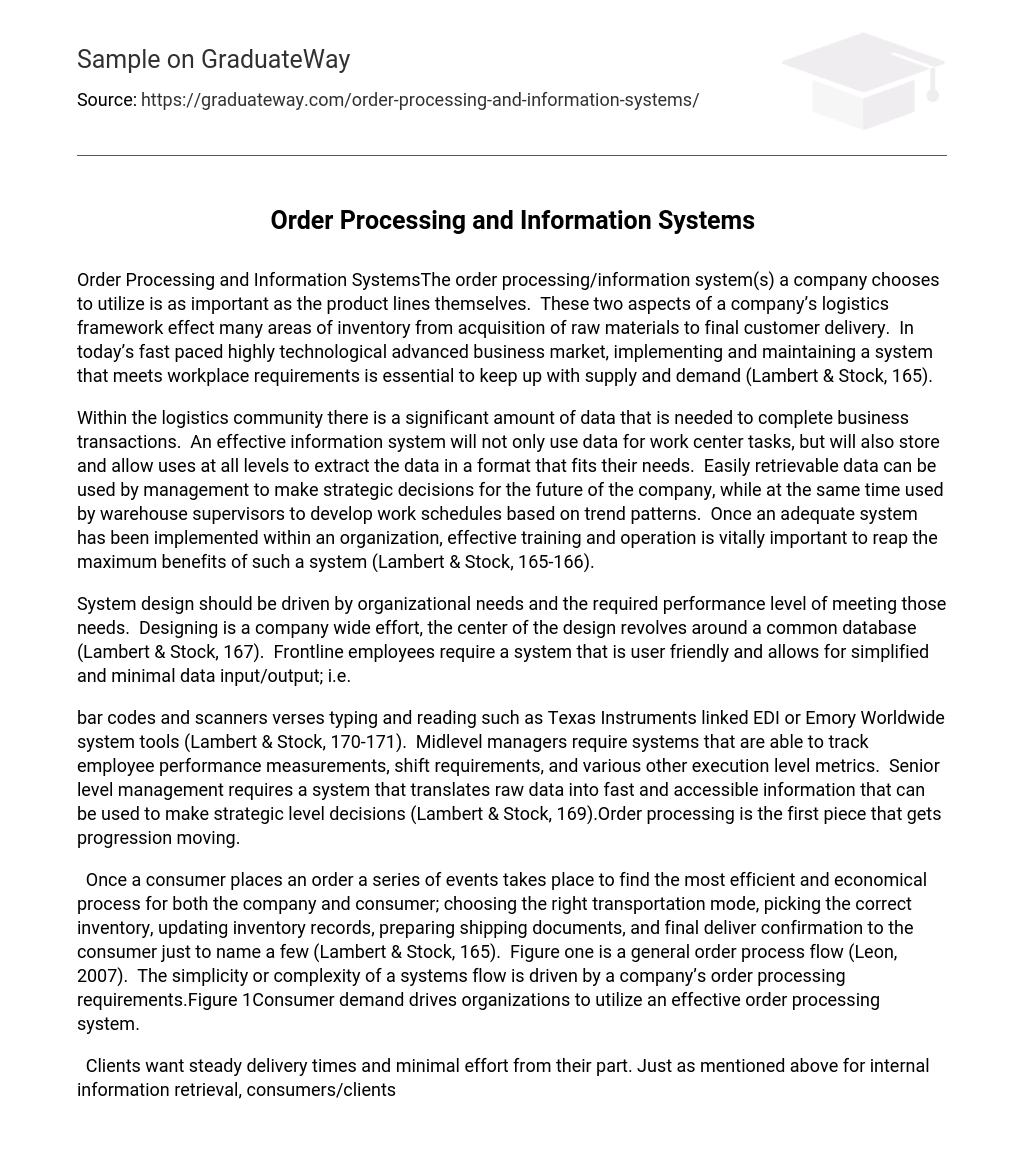Order Processing and Information SystemsThe order processing/information system(s) a company chooses to utilize is as important as the product lines themselves. These two aspects of a company’s logistics framework effect many areas of inventory from acquisition of raw materials to final customer delivery. In today’s fast paced highly technological advanced business market, implementing and maintaining a system that meets workplace requirements is essential to keep up with supply and demand (Lambert & Stock, 165).
Within the logistics community there is a significant amount of data that is needed to complete business transactions. An effective information system will not only use data for work center tasks, but will also store and allow uses at all levels to extract the data in a format that fits their needs. Easily retrievable data can be used by management to make strategic decisions for the future of the company, while at the same time used by warehouse supervisors to develop work schedules based on trend patterns. Once an adequate system has been implemented within an organization, effective training and operation is vitally important to reap the maximum benefits of such a system (Lambert & Stock, 165-166).
System design should be driven by organizational needs and the required performance level of meeting those needs. Designing is a company wide effort, the center of the design revolves around a common database (Lambert & Stock, 167). Frontline employees require a system that is user friendly and allows for simplified and minimal data input/output; i.e.
bar codes and scanners verses typing and reading such as Texas Instruments linked EDI or Emory Worldwide system tools (Lambert & Stock, 170-171). Midlevel managers require systems that are able to track employee performance measurements, shift requirements, and various other execution level metrics. Senior level management requires a system that translates raw data into fast and accessible information that can be used to make strategic level decisions (Lambert & Stock, 169).Order processing is the first piece that gets progression moving.
Once a consumer places an order a series of events takes place to find the most efficient and economical process for both the company and consumer; choosing the right transportation mode, picking the correct inventory, updating inventory records, preparing shipping documents, and final deliver confirmation to the consumer just to name a few (Lambert & Stock, 165). Figure one is a general order process flow (Leon, 2007). The simplicity or complexity of a systems flow is driven by a company’s order processing requirements.Figure 1Consumer demand drives organizations to utilize an effective order processing system.
Clients want steady delivery times and minimal effort from their part. Just as mentioned above for internal information retrieval, consumers/clients want to see what is available for their needs instantaneously. Today’s market thrives off product availability from suppliers and short lead times from order to delivery. Figure two depicts the rapid ability utilizing the just-in-time concept with a data processing system (Easy Link Services, n.
d.).Figure 2Further developed systems are designed utilizing the Enterprise Resource Planning (ERP) concept. These systems span the company from financial, inventory, and order information.
Cross department communication is conducted through these systems allowing the required data to be pulled from any level. SAP AG a firm out of Germany is the world’s leading ERP software provider. Their products are designed to work in a three-tier design allowing large amounts of data to be stored and seamless movement through the company’s divisions. When an order is inputted within the sales division, it is immediately sent to the warehouse for fill, the accounting section for billing, and transportation section for scheduling, all in a matter of seconds (Lambert & Stock, 176-177).
Point-of-Sale data gathering allows action from the time a consumer purchases an item from a retail purchase point. At the time an item is scanned from the retail point, the database sends though the system to the supplier to ship the item to replenish the stock automatically, however some companies prefer to have a physical view of the transaction. With today’s technology, databases have the ability to be programmed within parameters for stock levels that allow there to be a constant inventory on the shelf at a desired level. Wal-Mart utilizes a system like this that keeps the human hand out of the process and allows the database to do the work (Lambert & Stock, 171).
Tying as much of a company’s information into one data management system has the potential to directly improve their logistics function. Companies such as SAP AG are continuously developing innovative solutions to fit any business setting. Today and in the future, it is and will continue to improve for readily available information at everyone from the consumer to senior management for decision making purposes. This readily available information will continue to improve the quality of decision made from all levels.
ReferencesEasy Link Services. (n.d.).
Retrieved October 13, 2010, from http://www.icc.net/?en_US/?oc/?icc.net/?Resources/?EDITutorial/Leon, A.
(2007, June 2). Concept Draw 7. Retrieved October 13, 2010, from http://www.pegasusbookclub.
com/?2007/?06/?02/?cd-7.htmlStock, J. R., & Lambert, D.
M. (2001). Chapter 4. In Strategic Logisitcs Management (pp.
145-185). New York, NY: McGraw-Hill Irwin.





